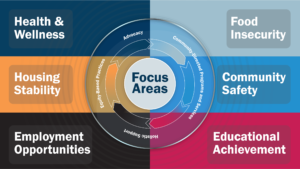Health and Wellness
Target programs: Adolescent Family Life Program, CA Prep, Community Health Center, Tobacco Education, African American Coalition
Fresno ranks 2nd in the nation for most year-round particle pollution; the average Fresno resident has more exposure to air pollution than 98% of census tracts in California and nearly 70% of census tracts in the United States.
Suicide is the second leading cause of death among young people between the ages of 10-24; LGBTQ+ youth are more than four times more likely to attempt suicide than their peers.
Educational Achievement
Target programs: Head Start 0-5, School of Unlimited Learning, Youthbuild Charter High School
Students that attend the Fresno Unified School district have a poverty rate of 46%. Inequities in diverse and effective teachers can impact parent engagement, student motivation, ability, and overall success of a school; teachers of race per 100 students are lowest for Latinx students (2.1) and Black students (2.6). In addition, the lowest rates of English and math proficiency in the 3rd grade are Black (34% in English and Math) and Latinx (41% in English and Math). These numbers mean that systemically we are failing to effectively educate over 60% of Black and Latinx students in our education systems.
Community Safety
Target programs: Advance Peace, Central Valley Against Human Trafficking (CVAHT), Foster Grandparent Program, Recycling, LGBTQ+ Resource Center
Incarceration rates have a devastating impact on neighborhoods and families and create economic instability in the household, elevating social and emotional stress for family members. Black men made up more than one-quarter (28%) of men incarcerated by the state – nearly five times higher than their share (5.8%) of all men in California. In addition, Black and Native American residents have the highest rates of injury in law enforcement incidents; predominately, Black and Latinx communities have the lowest rates of adults who feel safe in their neighborhood (Black 71.8% and Latinx 79.5%).
In 2020, 1,150 people were identified as victims of human trafficking, with almost 80% of those being sex trafficking, 14% labor trafficking, and 4% both. These numbers include 331 minors. In addition, these victims were 91.7% female-identifying. Fresno/Central Valley is at particular risk due to the significance of farm labor and access to immigrant populations.
Employment Opportunities
Target programs: Local Conservation Corps (LCC), Summer Internship Program, Valley Apprenticeship Connections (VAC), Workforce Connection Young Adult Program, Training and Employment Services
More than 40% of Black-owned businesses in the Fresno metro area have closed as a result of the COVID-19 pandemic; 38% of Fresno’s small businesses are minority-owned; the unemployment rate for Black residents (19.4%) is 2.5x higher than that of White residents (7.8%), and the Latinx rate is 1.3x higher (10%). In addition, the median household income is lowest for Black and Latinx residents, at $38,000/yr and $46,000/year, respectively.
Housing Stability
Target programs: Safe Place, Sanctuary Drop-In Center, Sanctuary Transitional Shelter, Sanctuary Housing Programs
Homeownership is the single largest source of wealth accumulation. Black and Latinx residents have the lowest rate of homeownership – 27.1% and 43.6%, respectively. Black and Native American residents have the highest rates for denied mortgage applications (15.4% and 18.8%, respectively); 28% of LGBTQ+ youth reported experiencing homelessness or housing instability at some point in their lives – and those who did had two to four times the odds of reporting depression, anxiety, self-harm, considering suicide, and attempting suicide compared to those with stable housing; during the pandemic, these zip codes had the highest eviction rates per 1,000 people in the Central Valley: 93701 (19.6), 93726 (10.5), 93704 (9.9), 93705 (9.3), 93721 (9.1), and 93728 (9.0).

